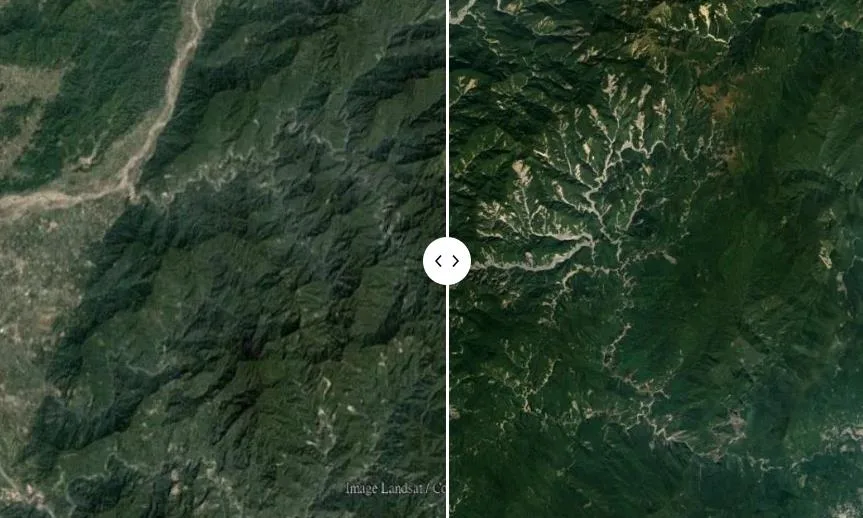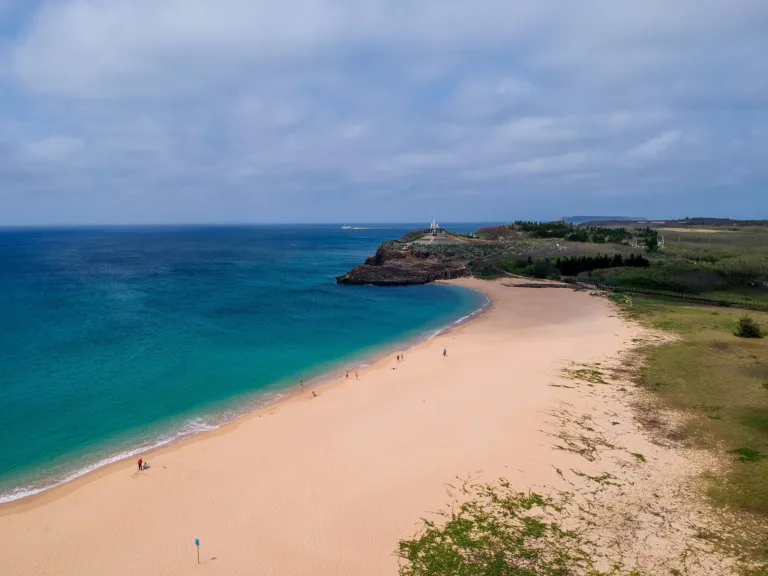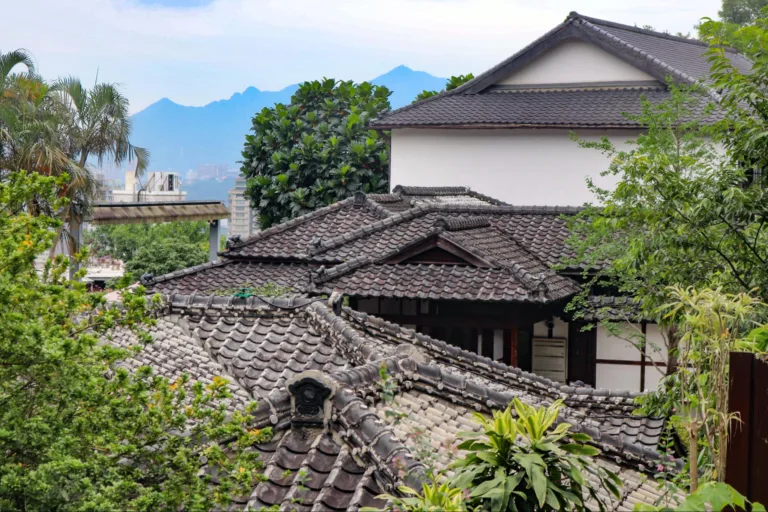With over 677 people killed in Taiwan, Typhoon Morakot (also known as the 88 Flood 八八水災) was the most deadly Typhoon ever to hit Taiwan in recorded history. It also broke records for the highest rainfall of any Typhoon in Taiwan’s history, a total of over 3 meters of rain (3060 mm in Alishan), with over 1500 mm of rain falling in less than 24 hours. The heavy rain led to a landslide in rural Kaohsiung that buried Xiaolin Village, killing 474 people. In this blog, we will provide a summary of the damage, the stories of people who lived through it, and the damage in the aftermath of the Typhoon.
Basic Summary of the Typhoon 莫拉克颱風大概的狀況
Typhoon Morakot began forming as a tropical depression on August 2nd, 2009, then strengthened to a category 1 Typhoon, and finally made landfall in Taiwan on August 7th, 2009. Its highest winds reached 140 km/h. When it made landfall in central, Taiwan, it had weakened to a tropical storm. It then slowed down and dumped rain on Taiwan for about three days until it exited via the Taiwan Strait and made landfall in China on August 9th, 2009. Over 3 meters of rain (3060 mm) were recorded in Alishan during the three days that the Typhoon affected Taiwan, which is the highest rainfall of any Typhoon to hit Taiwan. Most of Southern Taiwan was flooded. Overall the Typhoon caused over 3 billion dollars in damage.

Xiaolin Village (小林村) of Jiaxian Township, Kaohsiung County, population 1500, was hit by a landslide on August 8th, 2009 at 3:30 PM. 30 million metric tons of rock fell from Xiandu Mountain (獻肚山) traveling at over 180 km/h, burying the village in less than two minutes. In the end, 474 people were killed.
In Nantou, seven cars were washed into a river as Provincial Highway 16 collapsed.
In Taimali, Taitung County, several houses were washed downstream by floodwaters, and a hot spring hotel also fell into the river.
The Tsengwen Reservoir, Taiwan’s largest reservoir, was experiencing a drought and water rationing, but later was filled and ended up releasing 80% of its capacity as flood water discharge, flooding towns downstream.
For more details of the damage, you can check out Wikipedia in English or Chinese.
Stories of People Who Lived Through It 人們經歷莫拉克颱風的經驗:
I had not visited Taiwan yet in 2009, so I had no first-hand experience except seeing the Typhoon’s aftermath (as shown in the next section below). However, I just experienced Typhoon Kaimi which was eerily similar to Morakot. I recently asked my followers on Facebook and X if any of them had lived through Typhoon Morakot, and if so to please share their experience. Here are some of their responses:
From X (Twitter):
@OutRecording
We flew to Singapore by chance and missed it all. Came home and looked like someone power washed the hell out of all our outdoor furniture.
@AnimalExtender
I was in Taipei and in my recollection in Taipei it was no biggie. Obviously things were very different in the south. In my Taipei-centric memory, Soudelor in 2015 is still the typhoon that looms the largest.
@MorganBEverett
We flew back to Taipei from vacation as it was pulling away (we were delayed in Tokyo 16 hours due to the typhoon and had a pretty terrifying landing in Taoyuan). We were relieved to see minimal damage—and then the horrible news from down south started tricking in :,(
@formosajaymac
lots of rain. Very similar to the latest one.
@TaiwanRyan1980
My wife and I were in our 10ft floor apartment in Taoyuan and I went out before it arrived and rented a ton of movies and tv shows and we just watched a lot of TV.
@taiwandan
Almost every tree in our garden was ripped out the ground. Our kids swing/slide set from Costco which was bolted into steel H beams in the ground disappeared and never seen again. Wind so intense that some windows smashed and the howling noise was unbearable. So much rain that 2nd floor roof patio had about 0.5metres of water (drains blocked and we hadn’t drilled overflow holes at that point) which was pouring through cracks in door and running down the stairs. I had to quickly open and shut door (gallons of water flooding house) and crawl on the floor trying to avoid flying debris and unblock the drains in the dark. I have never been as scared in my life as that storm.
@vonsassyx
It was hard to sleep. The wind whistled and moaned, windows rattled like a freight train, & the false ceiling buckling and banging loudly with every gust. I went out and regretted it. Big sheets of broken signage hurled around. Almost impossible to walk. Rivers in the street.
@feeder_happier
I think it was one of the few times I went to Cashbox/Party World KTV.
@AviationKaGuru
Had 6 shots of single malt scotch watched youtube. Did calls with India and Dubai and US…nothing new !
From Facebook:
Jeffrey Framnes: I was in Taichung. Taichung had it easy, and within Taichung, we had it easy. But I was very blown away to witness the duration of the heavy rain. The big tragedy was a land or mud slide that killed hundreds, in the mountains down south.
Kim Nieuwhoff: Was in Taipei and very pregnant at the time. Stocked up on water and food and also a lot of Lego’s. Afterwards we donated all the clothes we could spare
Craig Crawford: Was in Tainan. No water for eight days after. Army trucks driving around picking up the thousands of pig carcasses that drowned in the flooding. Some factories in Rende flooded six to eight feet deep.
Jon Ward: Lived in Taichung at the time. As usual, I would say that Taichung was largely spared the worst of it, but it did rain a lot for a long time. A lot of apartments sprung leaks – the elevator in the 16F building I was living in shorted out! There was so much moisture in the walls, some of our wall sockets had to be replaced. Other parts of the island suffered far worse.
James Boyden: The strange thing about Morakot is that in Taichung the typhoon didn’t feel particularly strong.
Also, I remember it initially was forecast to strike in the north. I knew several people who changed their travel plans and headed south instead, only to get caught up in the typhoon when it changed course. One of them shared a video from the high speed rail train he was riding where it looked like he was traveling across a huge lake.
Trace Gomez: I think I was working in China and missed that one. The most destructive typhoon I ever witnessed hitting Taipei was Herb in 1996. That one the eye went right over Taipei and I saw the lightning and pitch black monster eye wall cloud and then felt the heat and calm air of the eye.
John Lamorie: In my 25+ years here it was the worst. I had designed/put in place the best defenses on my farm in the event of a heavy deluge. We did quite well for the first 2 metres of rain, but once the surrounding area started flooding there was nowhere for the rain on my farm to go. So we also were flooded. When the flood waters receded our 2,000 sq metre pond had Thailand shrimp, Snakehead fish, red tilapia., turtles and other aquatic animals. We Los more than 50 trees. So the cleanup took a while. One positive that came out of it was that “the world’s first (and only) paper schoolhouse’ survived unscathed.
Geological Changes 地理的改變
The real reason I wanted to write this blog is because of the landscape that I noticed while visiting Maolin which has distinct flat valleys full of debris. I was surprised to see from old satellite imagery on Google Earth that these valleys were once V-shaped before Morakot. It was clear to see that Morakot was a once-in-a-century disaster event. The geography of southern Taiwan was changed forever, which can still be seen from space. It was like a bomb went off over the southern mountains in Taiwan. Let me explain further.


Typhoon Morakot permanently changed the landscape, turning green V-shaped valleys in southern Taiwan into grey steep rock-filled canyons. Check out the before and after photos above (sorry if they don’t match perfectly.


Another example: Wanshan Village in Maolin, Kaohsiung once had much more green farmland next to the riverside. After Morakot, much of the farmland was swept away or buried under rubble.


Another example: Maolin Hot Spring once sat in this river valley below Duona. After Morakot, the entire hot spring area was buried in rocks and rubble.


And of course, the landslide that wiped out Siaolin Village, killing over 400 people. Sorry, this is the highest resolution available.

View of the riverbed below Wanshan Village in Maolin which used to have a suspension bridge and lots of farmland, but is now rocks and rubble.

Maolin Hot Spring once sat in this river valley below Duona. After Morakot, the entire hot spring area was buried in rocks and rubble.
Safety Precautions During a Typhoon 颱風天安全措施
- Secure loose outside objects
- If you live on the first floor of a flood-prone area, move as many valuables and important objects to higher floors as possible.
- Park your car/scooter on high ground
- Avoid going outside for your safety
- Stay out of the mountains
- Stay away from the ocean
- Have enough dry food and water ready for three days (72 hours) in case water and electricity are cut off.
If you follow the above rules, most Typhoons in Taiwan will not be dangerous. Also, most buildings in Taiwan are built with reinforced concrete that can withstand even the strongest winds, so stay indoors and you will be fine.
Conclusion 結論
Thanks for reading and I hope this blog is interesting and useful to you. Typhoon Morakot was truly an incredible historical event that forever changed the landscape of Taiwan. Taiwan has improved safety, especially in mountain villages where evacuations are now mandatory during typhoons. I hope we will never see a typhoon as deadly as this one in Taiwan again.
If you have more experiences to share, please leave them in the comments below.







